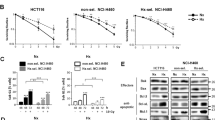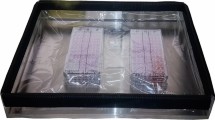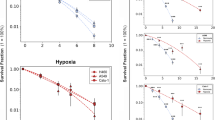Abstract
PR-000350, a novel hypoxic radiosensitizer, is a 2-nitroimidazole nucleoside analog and has begun to be used for clinical cancer therapy. In this study, using U937 monoblastoid cells we investigated the mechanisms of enhanced cell killing by PR-000350. When cells were irradiated under an extremely hypoxic condition, the apoptotic rate was strongly suppressed. However, a remarkable increase in the DNA fragmentation rate as well as in the ladder formation was observed when hypoxic cells were irradiated in the presence of 5 mM PR-000350. DNA histograms of the PR-000350 treated group showed enhancement of the sub-G1 fraction and simultaneous suppression of the progression of the cell cycle from the S to G2/M phase at 4–8 h after X-irradiation, suggesting the importance of the S phase in the induction of apoptotic cell death. Flow cytometric and immunohistochemical analyses after BrdU labelling revealed that apoptotic cell death is induced mainly in the BrdU-positive cells. In addition, by using cell synchronization technique it was proved that the S phase is the most sensitive fraction to the radiosensitizing effect of PR-000350. These results suggest that PR-000350 strongly enhances tumor cell killing by promoting X-ray induced-apoptosis preferentially in the S-phase fraction. PR-000350 is a new type radiosensitizer and promise to provide an effective anti-cancer activity against hypoxic tumor cells that are resistant to the usual radiotherapy.
Similar content being viewed by others
References
Tannock IF. Oxygen diffusion and the distribution of cellular radiosensitivity in tumours. Br J Radiol 1972; 45: 515–524.
Thomlinson RH. The implications of radiobiology for radiotherapists. Clin Radiol 1974; 24: 471–474.
Thomlinson RH. Hypoxia and tumours. J Clin Pathol 1977; 11: 105–113.
Olive PL, Durand RE. Detection of hypoxic cells in a murine tumor with the use of the comet assay. J Natl Cancer Inst 1992; 84: 707–711.
Gatenby RA, Kessler HB, Rosenblum JS, et al. Oxygen distribution in squamous cell carcinoma metastases and its relationship to outcome of radiationtherapy. Int J Radiat Oncol Biol Phys 1988; 14: 831–838.
Hockel M, Knoop C, Schlenger K, et al. Intratumoral pO2 predicts survival in advanced cancer of the uterine cervix. Radiother Oncol 1993; 26: 45–50.
Moulder JE, Rockwell S. Tumor hypoxia: its impact on cancer therapy. Cancer Metastasis Rev 1987; 5: 313–341.
Kastan MB, Onyekwere O, Sidransky D, Vogelstein B, Craig RW. Participation of p53 in the cellular response toDNAdamage. Cancer Res 1991; 51: 6304–6311.
Amellem O, Pettersen EO. Cell inactivation and cell cycle inhibition as induced by extreme hypoxia: the possible role of cell cycle arrest as a protection against hypoxia-induced lethal damage. Cell Prolif 1991; 24: 127–141.
Amellem O, Pettersen EO. Cell cycle progression in human cells following re-oxygenation after extreme hypoxia: consequences concerning initiation of DNA synthesis. Cell Prolif 1993; 26: 25–35.
Spiro IJ, Rice GC, Durand RE, Stickler R, Ling CC. Cell killing, radiosensitization and cell cycle redistribution induced by chronic hypoxia. Int J Radiat Oncol Biol Phys 1984; 10: 1275–1280.
Graeber TG, Peterson JF, Tsai M, Monica K, Fornace Jr. AJ, Giaccia AJ. Hypoxia induces accumulation of p53 protein, but activation of a G1–phase checkpoint by low-oxygen conditions is independent of p53 status. Mol Cell Biol 1994; 14: 6264–6277.
Graeber TG, Osmanian C, Jacks T, et al. Hypoxia-mediated selection of cells with diminished apoptotic potential in solid tumours. Nature 1996; 379: 88–91.
Overgaard J, Sand Hansen H, Andersen AP, et al. Misonidazole combined with split-course radiotherapy in the treatment of invasive carcinoma of larynx and pharynx. Report from the Dahanca 2 study. Int J Radiat Oncol Biol Phys 1989; 16: 1065–1068.
Overgaard J. Sensitization of hypoxic tumor cells. Clinical experience. Int J Radiat Biol 1989; 56: 801–811.
Lee D-J, Phillips TL, Coleman CN, et al. Logistics in designing clinical trials for etanidazole (SR 2508): An RTOG experience. Int J Radiat Oncol Biol Phys 1992; 22: 569–571.
Coleman CN, Buswell L, Noll L, Riese N, Rose M-A. The efficacy of pharmacokinetic monitoring and dose modification of etanidazole on the incidence of neurotoxicity: Results from a phase II trial of etanidazole and radiation therapy in locally advanced prostate cancer. Int J Radiat Oncol Biol Phys 1992; 22: 565–568.
Adams GE, Flockhart IR, Smithen CE, Stratford IJ, Wardman P, Watts ME. Electron-affinic sensitization, VII. A correlation between structure, one-electron reduction potentials and efficiencies of nitroimidazoles as hypoxic cell radiosensitizers. Radiat Res 1976; 67: 9–20.
Denny WA, Roberts PB, Anderson RF, Brown JM, Wilson WR. NLA-1: A 2–nitroimidazole radiosensitizer targeted to DNA by intercalation. Int J Radiat Oncol Biol Phys 1992; 22: 553–556.
Chassagne D, Charreau I, Sancho-Garnier H, Eschwege F, Malaise EP. First analysis on tumor regression for the European randomized trial of etanidazole combined with radiotherapy in head and neck carcinomas. Int J Radiat Oncol Biol Phys 1992; 22: 581–584.
Coleman CN, Bump EA, Kramer RA. Chemical modifiers of cancer treatment. J Clin Oncol 1988; 6: 709–733.
Wasserman TH, Phillips TL, Johnson RJ, et al. Initial United States clinical and pharmacological evaluation of misonidazole (RO-07–0582), a hypoxic cell radiosensitizer. Int J Radiat Oncol Biol Phys 1979; 5: 775–786.
Murayama C, Suzuki A, Sato C, et al. Radiosensitization by a new potent nucleoside analog: 1–(10,30,40-trihydroxy-20-butoxy)methyl-2–nitroimidazole (RP-343). Int J Radiat Oncol Biol Phys 1993; 26: 433–443.
Oya N, Shibamoto Y, Sasai K, et al. Optical isomers of a new 2–nitroimidazole nucleoside analog (PR-000350 series): Radiosensitization efficiency and toxicity. Int J Radiat Oncol Biol Phys 1995; 33: 119–127.
Koong AC, Chen EY, Giaccia AJ. Hypoxia causes the activation of nuclear factor kappa B through the phosphorylation of I kappa B alpha on tyrosine residues. Cancer Res 1994; 54: 1425–1430.
Vindeløv LL, Christensen IJ, Nissen NI. A detergent-trypsin method for the preparation of nuclei for flow cytometric DNA analysis. Cytometry 1983; 3: 323–327.
Ohashi M, Sugikawa E, Nakanishi N. Inhibition of p53 protein phosphorylation by 9–hydroxyellipticine: a possible anticancer mechanism. Jpn J Cancer Res 1995; 86: 819–827.
Shinomiya N, Tsuru S, Katsura Y, Sekiguchi I, Suzuki M, Nomoto K. Increased mitochondrial uptake of rhodamine 123 by CDDP treatment. Exp Cell Res 1992; 198: 159–163.
Gorczyca W, Bruno S, Darzynkiewicz RJ, Gong J, Darzynkiewicz Z. DNA strand breaks occurring during apoptosis: Their early in situ detection by the terminal deoxynucleotidyl transferase and nick translation assays and prevention by serine protease inhibitors. Int J Oncol 1992; 1: 639–648.
Adams GE, Stratford IJ, Edwards HS, Bremner JCM, Cole S. Bioreductive drugs as post-irradiation sensitizers: Comparison of dual function agents with SR 4233 and the mitomycin C analogue EO9. Int J Radiat Oncol Biol Phys 1992; 22: 717–720.
Warters RL. Radiation-induced apoptosis in a murine T-cell hybridoma. Cancer Res 1992; 52: 883–890.
McIlwrath AJ, Vasey PA, Ross GM, Brown R. Cell cycle arrests and radiosensitivity of human tumor cell lines: Dependence on wild-type p53 for radiosensitivity. Cancer Res 1994; 54: 3718–3722.
Kastan MB, Zhan Q, El-Deiry WS, et al. A mammalian cell cycle checkpoint pathway utilizing p53 and GADD45 is defective in ataxia-telangiectasia. Cell 1992; 71: 587–597.
O'Connor PM, Jackman J, Jondle D, Bhatia K, Magrath I, Kohn KW. Role of the p53 tumour suppressor gene in cell cycle arrest and radiosensitivity of Burkitt's lymphoma cell lines. Cancer Res 1993; 53: 4776–4780.
Brown R, Clugston C, Burns P, et al. Increased accumulation of p53 in cisplatin-resistant ovarian cell lines. Int J Cancer 1993; 55: 1–7.
Lazebnik YA, Cole S, Cooke CA, Nelson WG, Earnshaw WC. Nuclear events of apoptosis in vitro in cell-free mitotic extracts: A model system for analysis of the active phase of apoptosis. J Cell Biol 1993; 123: 7–22.
Oberhammer FA, Hochegger K, Froschl G, Tiefenbacher R, Pavelka M. Chromatin condensation during apoptosis is accompanied by degradation of lamin A+B, without enhanced activation of cdc2 kinase. J Cell Biol 1994; 126: 827–837.
Ling CC, Guo M, Chen CH, Deloherey T. Radiation-induced apoptosis: Effects of cell age and dose fractionation. Cancer Res 1995; 55: 5207–5212.
Zamai L, Falcieri E, Gobbi P, et al. Anti-BrdUrd labeling of newly synthesized DNA in HL-60 cells triggered to apoptosis. Cytometry 1996; 25: 324–332.
Author information
Authors and Affiliations
Rights and permissions
About this article
Cite this article
Kuno, Y., Shinomiya, N. PR-000350, a novel hypoxic radiosensitizer, enhances tumor cell killing by promoting apoptosis preferentially in the S-phase fraction. Apoptosis 5, 69–77 (2000). https://doi.org/10.1023/A:1009641827022
Issue Date:
DOI: https://doi.org/10.1023/A:1009641827022




